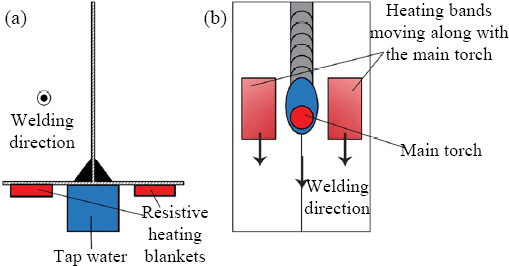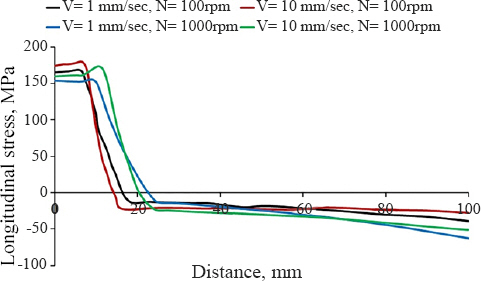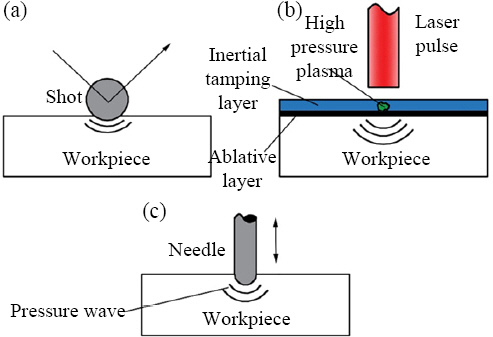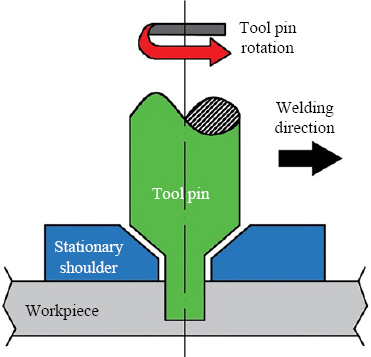2. J. H. Hattel, M. R. Sonne, and C. C. Tutum, Modelling residual stresses in friction stir welding of Al alloys a review of possibilities and future trends,
Int. J. Adv. Manuf. Technol. 76 (2015) 1793ŌĆō1805.
https://doi.org/10.1007/s00170-014-6394-2
[CROSSREF] 3. N. Kumar, R. S. Mishra, and J. A. Baumann, Model for Understanding Residual Stress Development in Friction Stir Welded Structures. In:Residual Stresses in Friction Stir Welding,
1st edition Butterworth-Heinemann. (2013) 28ŌĆō35.
[CROSSREF] 4. J. He, Z. Ling, and H. Li, Effect of tool rotational speed on residual stress, microstructure, and tensile properties of friction stir welded 6061-T6 aluminum alloy thick plate,
Int. J. Adv. Manuf. Technol. 84 (2016) 1953ŌĆō1961.
https://doi.org/10.1007/s00170-015-7859-7
[CROSSREF] 6. M. Peel, A. Steuwer, M. Preuss, and P. J. Withers, Microstructure, mechanical properties and residual stresses as a function of welding speed in aluminium AA5083 friction stir welds,
Acta. Mater. 51 (2003) 4791ŌĆō4801.
https://doi.org/10.1016/S1359-6454(03)00319-7
[CROSSREF] 7. Z. Feng, X. L. Wang, S. A. David, and P. S. Sklad, Modelling of residual stresses and property distributions in friction stir welds of aluminium alloy 6061-T6,
Sci. Technol. Weld. Join. 12 (2007) 348ŌĆō356.
https://doi.org/10.1179/174329307X197610
[CROSSREF] 10. D. Camilleri, D. Micallef, and P. Mollicone, Thermal stresses and distortion developed in mild steel DH36 friction stir-welded plates:An experimental and numerical assessment,
J. Therm. Stress. 38 (2015) 485ŌĆō508.
https://doi.org/10.1080/01495739.2015.1015856
[CROSSREF] 12. Z. Zhang, Z. Zhang, and . Zhang, Numerical investigations of size effects on residual states of friction stir weld,
Proceeding of the Institution of Mechanical Engineers, Part B:J. Eng. Manuf. 228 (2014) 572ŌĆō581.
https://doi.org/10.1177/0954405413506191
[CROSSREF] 13. M. I. Costa, C. Leit├Żo, and D. M. Rodrigues, Parametric study of friction stir welding induced distortion in thin aluminium alloy plates:A coupled numerical and experimental analysis,
Thin.Walled. Struct. 134 (2019) 268ŌĆō276.
https://doi.org/10.1016/j.tws.2018.10.027
[CROSSREF] 15. R. W. McCune, A. Murphy, M. Price, and J. Butterfield, The influence of friction stir welding process idealization on residual stress and distortion predictions for future airframe assembly simulations,
J. Manuf. Sci. Eng. Trans. 134 (2012) 1ŌĆō10.
https://doi.org/10.1115/1.4006554
[CROSSREF] 16. P. Sun and X. Michaleris, Finite element analysis of thermal tensioning techniques mitigating weld buckling distortion, Weld. J. 76 (1997) 451-s
17. P. Michaleris, J. Dantzig, and D. Tortorelli, Minimization of welding residual stress and distortion in large structures, Weld. J. 78 (1999) 361-s
18. K. K. Tamma, Encyclopedia of Thermal Stresses, Springer Publishers. (2013)
19. D. A. Price, S. W. Williams, A. Wescott, C. J. Rezai, A. Harrison, A. M. Peel, P. Staron, and M. Kocak, Steuwer, Distortion control in welding by mechanical tensioning,
Sci. Technol. Weld. Join. 12 (2007) 620ŌĆō633.
https://doi.org/10.1179/174329307x213864
[CROSSREF] 23. J. Altenkirch, A. Steuwer, P. J. Withers, S. W. Williams, M. Poad, and S. W. Wen, Residual stress engineering in friction stir welds by roller tensioning,
Sci. Technol. Weld. Join. 14 (2009) 185ŌĆō192.
https://doi.org/10.1179/136217108x388624
[CROSSREF] 25. W. He, M. Li, Q. Song, J. Liu, and W. Hu, Efficacy of External Stationary Shoulder for Controlling Residual Stress and Distortion in Friction Stir Welding,
Trans. Indian Inst. Met. 72 (2019) 1349ŌĆō1359.
https://doi.org/10.1007/s12666-019-01630-2
[CROSSREF] 26. W. He, J. Liu, W. Hu, G. Wang, and W. Chen, Controlling residual stress and distortion of friction stir welding joint by external stationary shoulder,
High Temp. Mater. Process,. 38 (2019) 662ŌĆō671.
https://doi.org/10.1515/htmp-2019-0005
[CROSSREF] 31. M. Z. H. Khandkar, J. A. Khan, and A. P. Reynolds, Prediction of temperature distribution and thermal history during friction stir welding:Input torque based model,
Sci. Technol. Weld. Join. 8 (2003) 165ŌĆō174.
https://doi.org/10.1179/136217103225010943
[CROSSREF] 39. C. Desrayaud, S. Ringeval, S. Girard, and J. H. Driver, A novel high straining process for bulk materials The development of a multipass forging system by compression along three axes,
J. Mater. Process Technol. 172 (2006) 152ŌĆō158.
https://doi.org/10.1016/j.jmatprotec.2005.09.015
[CROSSREF] 50. L. Wang, C. M. Davies, R. C. Wimpory, L. Y. Xie, and K. M. Nikbin, Measurement and simulation of temperature and residual stress distributions from friction stir welding AA2024 Al alloy,
Mater. High. Temp. 27 (2010) 167ŌĆō178.
https://doi.org/10.3184/096034010X12813743510192
[CROSSREF] 52. M. Riahi and H. Nazari, Analysis of transient temperature and residual thermal stresses in friction stir welding of aluminum alloy 6061-T6 via numerical simulation,
Int. J. Adv. Manuf. Technol. 55 (2011) 143ŌĆō152.
https://doi.org/10.1007/s00170-010-3038-z
[CROSSREF] 53. A. H. Jamshidi, S. Serajzadeh, and A. H. Kokabi, Experimental and theoretical evaluations of thermal histories and residual stresses in dissimilar friction stir welding of AA5086-AA6061,
Int. J. Adv. Manuf. Technol. 61 (2012) 149ŌĆō160.
https://doi.org/10.1007/s00170-011-3713-8
[CROSSREF] 56. M. R. Sonne, C. C. Tutum, J. H. Hattel, A. Simar, and B. D. Meester, The effect of hardening laws and thermal softening on modeling residual stresses in FSW of aluminum alloy 2024-T3,
J. Mater. Process Technol. 213 (2013) 477ŌĆō486.
https://doi.org/10.1016/j.jmatprotec.2012.11.001
[CROSSREF] 59. C. Casavola, A. Cazzato, V. Moramarco, and C. Pappalettere, Influence of the clamps configuration on residual stresses field in friction stir welding process,
J. Strain Anal. Eng. Des. 50 (2015) 232ŌĆō242.
https://doi.org/10.1177/0309324715573361
[CROSSREF] 62. S. B. Aziz, M. W. Dewan, D. J. Huggett, M. A. Wahab, A. M. Okeil, and T. W. Liao, Impact of Friction Stir Welding (FSW) process parameters on thermal modeling and heat generation of aluminum alloy joints,
Acta. Metall. Sin. 29(2016) 869ŌĆō883.
https://doi.org/10.1007/s40195-016-0466-2
[CROSSREF] 63. M. Bachmann, J. Carstensen, L. Bergmann, J. F. D. Santos, C. S. Song, and M. Rethmeier, Numerical simulation of thermally induced residual stresses in friction stir welding of aluminum alloy 2024-T3 at different welding speeds,
Int. J. Adv. Manuf. Technol. 91 (2017) 1443ŌĆō1452.
https://doi.org/10.1007/s00170-016-9793-8
[CROSSREF] 65. Z. Hou, J. Sheikh-Ahmad, F. Jarrar, and F. Ozturk, Residual Stresses in Dissimilar Friction Stir Welding of AA2024 and AZ31:Experimental and Numerical Study,
J. Manuf. Sci. Eng. Trans. 140 (2018) 1ŌĆō10.
https://doi.org/10.1115/1.4039074
[CROSSREF] 67. S. Salimi, P. Bahemmat, and M. Haghpanahi, Study on residual stresses caused by underwater friction stir welding:FE modeling and ultrasonic measurement,
Proceedings of the Institution of Mechnical Engineers, Part E:J. Process Mech. Eng. 233 (2019) 118ŌĆō137.
https://doi.org/10.1177/0954408917751963
[CROSSREF] 68. X. X. Zhang, L. H. Wu, H. Andr├ż, W. M. Gan, M. Hofmann, D. Wang, D. R. Ni, B. L. Xiao, and Z. Y. Ma, Effects of welding speed on the multiscale residual stresses in friction stir welded metal matrix composites,
J. Mater. Sci. Technol. 35 (2019) 824ŌĆō832.
https://doi.org/10.1016/j.jmst.2018.11.005
[CROSSREF]














 PDF Links
PDF Links PubReader
PubReader ePub Link
ePub Link Full text via DOI
Full text via DOI Download Citation
Download Citation Print
Print



